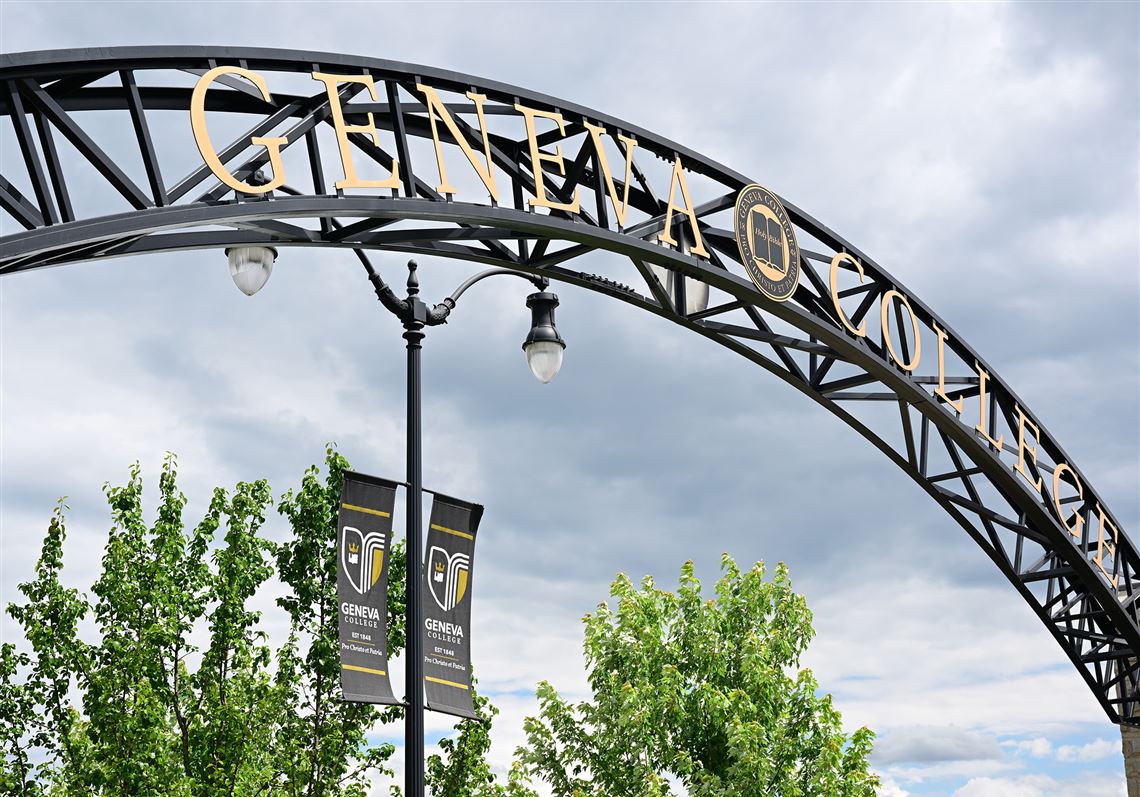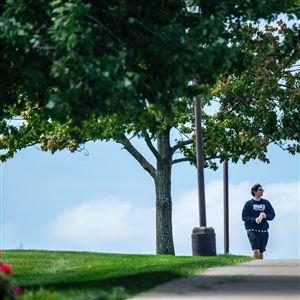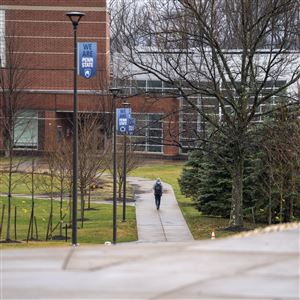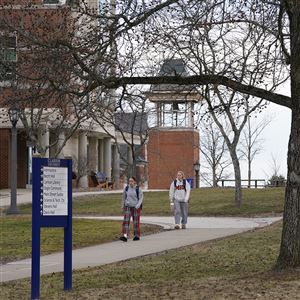When the Great Recession gripped the United States in 2008, people started having fewer babies. Between 2007 and 2022, the birth rate plummeted 23%.
Nearly 18 years later, experts say the country, particularly the Northeast and Midwest, is headed toward a demographic cliff: a projected decrease in the population of young adults that will start in 2025.
This means those falling birth rates will soon catch up with colleges — and the enrollment declines that many schools have been facing could get worse.
There’s even a phrase for this in the higher education realm: the enrollment cliff.
“It is frightening,” said Mary Finger, president of Seton Hill University.
Because of this, many Pittsburgh-area colleges are taking an introspective look at their offerings and operations, making changes and introducing new opportunities where they see fit. Their efforts include everything from reducing tuition sticker prices to introducing new academic programs, all in the hope of attracting more students from a diminishing pool of people.
The Post-Gazette spoke with college leaders at six private, regional schools — Seton Hill University, Point Park University, Washington & Jefferson College, Geneva College, Carlow University and Chatham University — about unique ways that they’re preparing for the cliff.
With the exception of Chatham, all of these colleges enrolled fewer students in fall 2022 than they did a decade earlier in fall 2013. Enrollment declines have delivered blows to private colleges, as well as other regional institutions like Pennsylvania’s state-owned universities and the Penn State branch campuses.
Despite the bleak projections, most of the school leaders interviewed were optimistic that they will face the cliff head-on and bring more students to their campuses.
Ms. Finger, who began leading Seton Hill 10 years ago and has worked in higher education for four decades, believes there is an inherent value in a college degree that can’t be shaken.
“The value of a college education is still indisputable,” she said. “[The enrollment cliff] is something to be concerned about — it’s always something to be concerned about … Staying relevant and nimble is really the key.”
An expected problem
This drop-off in college-aged students wasn’t unexpected, said Julie Wollman, a professor who studies college leadership in the University of Pennsylvania’s Graduate School of Education.
Predictions of the 2025 enrollment cliff date back to 2011. Recent projections anticipate the share of 18-year-olds in the U.S. will drop from 4.3 million to 4.2 million between 2025 and 2033, and will continue to shrink to 3.8 million by 2039.
Despite that, many schools spent the early and mid 2010s building new dorms and adding superfluous academic programs — ignoring warnings from canaries in the higher education coal mine.
Even canaries perhaps couldn’t have predicted some of the other challenges that would plague higher education institutions in the 2020s. The pandemic, high tuition costs, heightened competition, diminished trust and more employment pathways that don’t require college degrees have all exacerbated the enrollment cliff issue for schools.
“What most institutions typically do — the president, the senior leadership team [and] the board of trustees — is they tend to think they're the only institution that's not going to be affected by these problems,” Ms. Wollman said. “... It's human nature to just not pay attention to all the signs until it gets so bad that it's too late.
“I think some schools have done a good job of paying attention before it's too late. Hopefully we'll see more of that.”
Expanding recruitment footprints
There simply aren’t enough high school students in the Pittsburgh region for local colleges to maintain steady enrollments, believes Marlin Collingwood, Point Park’s vice president of enrollment management and marketing.
That’s why the Downtown college is casting a wider net to recruit new students.
In the past, Point Park would recruit within a 2.5-hour radius of Pittsburgh. Now, the university has expanded that radius to include Eastern Pennsylvania, Maryland, Virginia, the Columbus, Ohio, area and western New York.
“Expanding our footprint has been really important,” Mr. Collingwood said.
Branching out beyond Pennsylvania could be vital as the Keystone State has seen its own diminishing fertility rate in the past 15 years. Between 2008 and 2023, the state’s K-12 public schools saw a 5.6% drop in enrollment — a loss of more than 100,000 students.
Point Park hopes to grow its enrollment as much as 30% by 2030, in part by widening recruitment boundaries. Leaders are also leveraging the school’s Downtown location to appeal to prospective students.
“The biggest thing that differentiates us from anybody else in this region is the fact that we're located Downtown,” Mr. Collingwood said, “and the opportunities that that provides for our students … to have a chance to literally live in the downtown of a major city.”
Bringing affordability to the forefront
Colleges aren’t just vying for a smaller pool of students. They’re also competing for a group that is increasingly skeptical of the worth of a college degree.
In 2009, of 130,647 high school graduates at Pennsylvania public schools, 73% planned to go to college, according to state Department of Education data.
Fast forward 14 years, and in 2023, the number of graduates had dropped to 125,051 — and just 61% were college-bound. Costs are becoming a growing deterrent for many high school grads.
Acknowledging affordability wariness, Washington & Jefferson reduced its tuition sticker price by 44% to better reflect its costs. At private colleges like W&J, sticker prices often don’t give an accurate picture of how much students will actually pay for their education since these prices don’t factor in scholarships.
“We see in many institutions really high sticker prices on tuition, but there are extremely high scholarships and discounts that just stack on top of it,” said Tracey Sheetz, W&J’s vice president of enrollment. “When students see that extremely high sticker price, they don't look any further because they might not realize that's what institutions do.”
The Washington County school also simplified its scholarship offerings by putting all scholarships under one “merit” scholarship, Ms. Sheetz added. Applicants find out the worth of that merit scholarship immediately upon admission.
And W&J offers a scholarship to prospective students who visit its campus. Point Park and several other regional institutions do the same.
Affordability is a key priority for officials at Geneva College, too. That’s why the Beaver Falls school launched a program that guarantees free tuition to some Geneva students.
Beginning with the fall 2024 class, Pennsylvania students whose families earn less than $70,000 annually will pay no undergraduate tuition at the Christian college. The college will also offer its highest-achieving students scholarships of up to $20,000 annually, or up to $80,000 total over four years.
Between the Tuition Promise program and a college-wide rebrand, Geneva saw an uptick in applications this year, said Willem de Ruijter, vice president of enrollment and marketing.
“We've been one of the more affordable Christian colleges in the Northeast [and] Midwest for a very, very long time,” Mr. de Ruijter said. “That was not something that people knew about us. [We thought,] ‘OK, we're already doing this, how do we articulate it better?’
“Launching the Tuition Promise … has really helped put Geneva as an option on the table for families.”
Attracting nontraditional students
Grappling with the fact that there are fewer “traditional-aged” students, some schools are trying to bring more adult learners into their classrooms.
That’s been in part achieved through articulation agreements with community colleges, which typically draw more adult students than their four-year counterparts.
And schools are amping up degree pathways that cater to adult schedules. Anticipating the demographic cliff back in 2016, Carlow in Oakland began moving more of its programs online, said Mollie Cecere, the school’s vice president of enrollment management.
“We stepped back as an institution years ago to say, ‘We know [the demographic cliff] is coming. We're not going to sit here and wait for it to come. How do we use who we uniquely are? How do we look at what the region's needs are, build from those strengths, and develop the right program?’” Ms. Cecere said.
In fall 2022, the campus enrolled nearly 400 undergraduate students over the age of 25, according to data from the Department of Education. Those students made up nearly a third of the Catholic school’s undergraduate enrollment that semester.
Some of those students might be taking college classes for the first time. Others might be interested in Carlow’s graduate programs, university officials said.
And still others have some college, but no degree — a demographic that’s growing nationally. These people made up nearly one-fifth of U.S. adults in 2021.
It’s a key focus area for Carlow, said university President Kathy Humphrey.
“There are a lot of people out there that are looking to finish college … Many people started a degree, never finished, but they've gotten a lot of work experience,” Ms. Humphrey said. “How do we walk in that chaos? How do we get back with them and say, ‘OK … Let's build a curriculum around your expertise to help you get to where you want to be.’”
Introducing new programs and phasing out others
Leaders at schools like Seton Hill and Chatham believe that meeting student desires and regional needs can also bolster enrollments.
Seton Hill has introduced 40 new programs, certificates and specializations in the past eight years, Ms. Finger said.
New offerings at the Greensburg university include a cybersecurity undergraduate program and a doctor of physical therapy program that graduated the school’s first doctoral students in May.
“If an idea seemed viable — based on census data and job data, and it was consistent with our mission — we put development teams together,” Ms. Finger said. “... We’ve made sure that these are programs that the community needs.”
At Chatham in Shadyside, a new School of Business & Enterprise will launch this fall. The university will also introduce a sports management degree in 2025.
Debbie DeLong, a Chatham marketing professor who will serve as the business school’s executive director, said plans for the budding school will focus on business sustainability — a focus that could meet regional needs.
“Business sustainability is a very strong interest, not only in Pittsburgh, but in general with students pursuing business careers,” Ms. DeLong said. “The industry is moving in the direction of recognizing that sustainability is not just a buzzword, it really is about business resilience.”
The university is also “sunsetting” some programs — such as a social services administration undergrad program and a graphic design graduate program — that weren’t attracting many students.
Lisa Lambert, the university’s vice president for academic affairs, said school officials felt they needed to be “more sensitive to the market” and pay attention to “what students want now.”
Chatham has seen an enrollment uptick over the past decade — largely attributable to the former women’s college’s decision to begin enrolling male students in 2015.
Ms. Lambert expects Chatham to continue to grow its enrollment, despite the demographic cliff.
Soon to be in her 40th year at Chatham, she said she has seen several of these cliffs materialize throughout her career. Unlike some other colleges, Chatham was able to evolve, Ms. Lambert said — and she trusts that the university will continue to do so.
“I think I've got that longer view of things where I see, yes, change is inevitable, [but] change is not necessarily something to be frightened of,” Ms. Lambert said. “It is something to acknowledge, embrace and move forward.
“That's why I'm very excited about our future. I'm very inspired by our long traditions, but also cognizant of what challenges we face. I think we’ve got the tools to make it.”
First Published: June 16, 2024, 9:30 a.m.
Updated: June 17, 2024, 7:16 p.m.
























